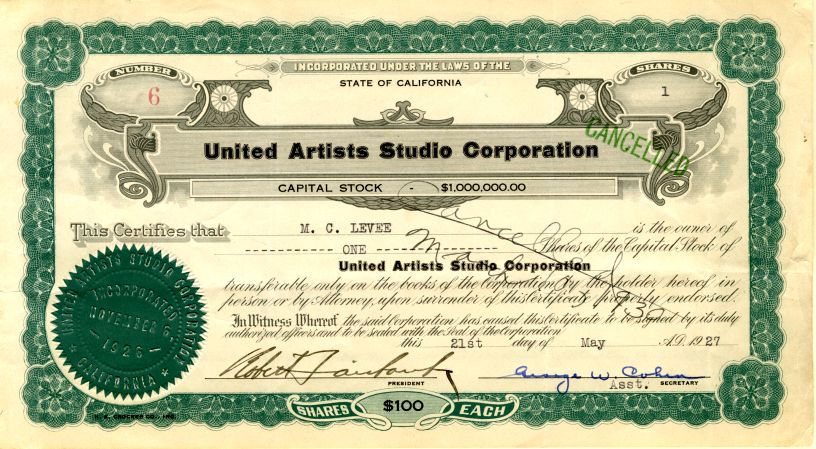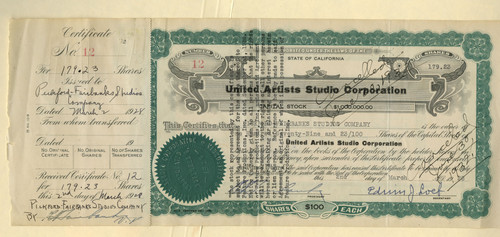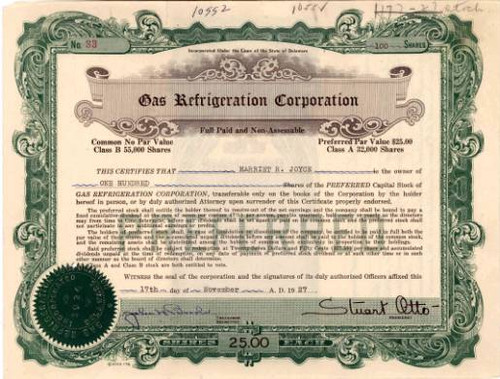Beautiful RARE certificate #6 from United Artists Studio Corporation issued on May 21, 1927. This historic document has an ornate border around it with the company's name on top center. This item has the signatures of the Company's President, Robert Fairbanks and Secretary, George W. Cohen. The certificate was issued to M. C. Levee and is over 88 years old. Robert Fairbanks, the brother of Douglas Fairbanks, Sr. was the president of the corporation. George W. Cohen was one of the original founders of the International Academy of Motion Picture Arts and Sciences. The certificate was issued to M.C. Levee and endorsed by him on the back. 
Certificate United Artist was organized as a joint venture on February 5, 1919 by four of the leading figures in early Hollywood: Charles Chaplin, Douglas Fairbanks, Mary Pickford, and D. W. Griffith. The idea for the venture originated with Fairbanks, Chaplin, Pickford, and cowboy star William S. Hart a year earlier as they were traveling around the U.S. selling Liberty bonds to help the World War I effort. Already hardened veterans of Hollywood, the four film stars began to talk of forming their own company to better control their own work as well as their futures. With the addition of Griffith, planning began, but Hart bowed out even before things had formalized. When he heard about their scheme, Richard A. Rowland, head of Metro Pictures, said, "The inmates are taking over the asylum." The four partners, with advice from former Secretary of the Treasury William G. McAdoo (son-in-law of then-President Woodrow Wilson), formed their distribution company, with Hiram Abrams as its first managing director. The original terms called for Pickford, Fairbanks, Griffith and Chaplin to produce five pictures each year. But by the time the company got under way in 1920-1921, feature films were becoming more expensive and more polished, and running times had settled at around ninety minutes (or eight reels). It was soon clear that no one, no matter how popular, could produce and star in five films a year. By 1924, by which time Hart and Griffith had dropped out, the company was facing a crisis: either bring in others to help support a costly distribution system or concede defeat. The veteran producer Joseph Schenck was hired as president. Not only had he been producing pictures for a decade, but he brought along commitments for films starring his wife, Norma Talmadge, his sister-in-law, Constance Talmadge, and his brother-in-law, Buster Keaton. Contracts were signed with a letter of independent producers, especially Samuel Goldwyn, Alexander Korda and Howard Hughes. Schenck also formed a separate partnership with Pickford and Chaplin to buy and build theaters under the United Artists name. United Artists expanded to include are nine producers -- Mary Pickford, Douglas Fairbanks, Charles Chaplin, D. W. Griffith, Gloria Swanson, Samuel Goldwyn, Feature Productions, Inc., Art Cinema Co., and United Artists Studios, Inc. By 1938 Samuel Goldwyn had accumulated over 50 percent of the stock and changed the name to Samuel Goldwyn Studios. Feature Productions produced "The Son of the Sheik" in 1926. Directed by: George Fitzmaurice. Cast: Rudolph Valentino, Vilma Banky, George Fawcett, Montague Love, Bull Montana. It was Rudolph Valentino's last film. Sorrell and Son (1927) was alos produced by Feature Productions. Distributor: United Artists. Presenter: Joseph M. Schenck. Director-Scenario: Herbert Brenon. Adaptation: Elizabeth Meehan. Photography: James Wong Howe. Set Design: Julian Boone Fleming. Editor: Marie Halvey. Assistant Director: Ray Lissner. Makeup: Fred C. Ryle. Cast: H.B. Warner, Anna Q. Nilsson, Mickey McBan, Carmel Myers, Lionel Belmore, Norman Trevor, Betsy Ann Hisle, Louis Wolheim, Paul McAllister, Alice Joyce, Nils Asther, Mary Nolan. Man suffers privations as he raises son alone, who grows up to be a surgeon. 10 reels, 9,900 ft. This film was recently rediscovered and restored (Academy Film Archive, poor image quality, last 5 minutes missing) The Bat (1926) Directed by Roland West was also produced by Feature Productions, Incorporated, production; distributed by United Artists Corporation. / Produced by Joseph M. Schenck. Scenario by Roland West with continuity by Julien Josephson, from the play adaptation The Bat by Mary Roberts Rinehart and Avery Hopwood of the novel The Circular Staircase by Mary Roberts Rinehart. Production design by William Cameron Menzies. Production assistants Frank Hall Crane, Hal C. Kern, Thornton Freeland and Ned Herbert Mann. Cinematography by Arthur Edeson. Intertitles by George Marion Jr. / © 23 March 1926 by Feature Productions, Incorporated [LP22528]. New York premiere circa 14 March 1926. Released 5 April 1926. Roland West remake this film as The Bat Whispers (1930). Cast: André de Béranger (André Beranger) [Gideon Bell], Charles W. Herzinger [the man in the black mask], Emily Fitzroy [Miss Cornelia Van Gorder], Louise Fazenda [Lizzie Allen], Arthur Houseman [Richard Fleming], Robert McKim [Dr. Wells], Jack Pickford [Brooks Bailey], Jewel Carmen [Miss Dale Ogden], Sojin Kamiyama [Billy], Tullio Carminati [Moletti], Eddie Gribbon [Detective Anderson], Lee Shumway [The Unknown] George Cohen was one of the original founders of the International Academy of Motion Picture Arts and Sciences (the "International" was later dropped during incorporation proceedings). The thirty-six included Mayer, Nagel, Niblo, and Beetson, J.A. Ball, Richard Barthelmess, Charles H. Christie, George Cohen, Cecil B. DeMille, Douglas Fairbanks, Joseph W. Farnham, Cedric Gibbons, Benjamin Glazer, Sid Grauman, Milton Hoffman. Jack Holt, Henry King, Jesse Lasky, M.C. Levee, Frank Lloyd, Harold Lloyd, Edwin J. Loeb, Jeanie MacPherson, Bess Meredyth, Mary Pickford, Roy Pomeroy, Harry Raph, Joseph Schenck, Milton Sills, John Stahl. Irving Thalberg, Raoul Walsh, Harry Warner, Jack L. Warner, Carey Wilson and Frank Woods.
M.C. Levee (January 18, 1891, Chicago May 24, 1972, Palm Springs, California) was born Michael C. Levee. Beginning his career as a prop man, Levee worked his way up to an executive at several different studios, including First National Studios, United Artists Studios, and Paramount Pictures. Levee was one of the original 36 founding members of the Academy of Motion Picture Arts and Sciences (AMPAS) and served as the third president from 1931-1932. Levee was also one of Hollywood's top agents until his retirement in 1956, working with such stars as Mary Pickford, Joan Crawford, and many more. Levee was one of six children growing up in Chicago. He had four brothers named Louis, George, Eddie and Sidney and a sister named Rose Levee. He was married to Rose (Mimi) Levee and had 2 sons. His oldest son, Michal Levee Jr., served as Vice-President of Radnite-Mattel Productions. His youngest son, John Levee, is a painter living in Paris. Levee died at the age of 83 from cancer in Palm Springs, California. His second marriage was to Trudy Levee. Levee began his career in the film industry by working as a prop man at Fox Film Corporation in 1917, earning $20 a week working on A Tale of Two Cities. Within a year, Levee became the assistant to Abe Carles, the General Superintendent at Fox. Levee left Fox in 1920 in order to become a business man at Robert Brunton Studios with Robert Brunton. In 1920, Levee organized United Studios, serving as President. While working at United Studios, Levee produced The Isle of Lost Ships (1923), The White Moth (1924), starring Barbara La Marr, and Sweet Daddies (1926). In April 1926, Levee sold United Studios to Paramount Pictures. Levee then joined First National, also known as Warner Bros., in order to build more studio facilities in Burbank. Levee joined Nicholas Schenck as General Studio and Business Manager until 1929, when he left to become Executive Manager at Paramount. In 1932, Levee was let go by Sam Jaffe, the General Production Manager, who believed he could cover both jobs. Levee was also the founder and first President of Artists Management Guild. In the 1930s Levee started the M.C. Levee Agency directly after working at United Artists. He ran a one-man business with no staff or organization. He had several important clients, most of which were from Warner Brothers. Most agents do not stick to one studio, it was simply a coincidence that Levee's client base were all working under Warner Brothers. Because he had several large clients, Levee was very well off. Some of Levee's star clients included Mary Pickford, Joan Crawford, Merle Oberson, Bette Davis, Paul Muni, Jeanette MacDonald, Leslie Howard, Greer Garson, Claude Rains, Dick Powell, and Franchot Tone. He was also the agent of creators Cecil B. DeMille, Frank Borzage, and Mervyn LeRoy. Robert Cowan referred to Levee as being a fair and reliable agent. In 1927, the Academy of Motion Picture Arts and Sciences was founded in order to improve the media industry without receiving government help. The founders knew they could create a stronger industry by establishing unity between all groups such as writers, directors, and technicians. With such exponential growth in American film, the industry also desperately needed a standardization of equipment and techniques. The founders saw that gathering a group of professionals together could create a positive response to the issues facing the industry and so the Academy of Motion Picture Arts and Sciences was born. Levee was considered one of the fathers of the Academy alongside Douglas Fairbanks, Conrad Nagel, Milton Sills, William C. deMille and Thalberg. Much of the work Levee did for the Academy was for little or no pay, working simply for the good of the Academy. Levee, along with the other 35 founding members had great hope for what the Academy could become for the film industry. They hoped to establish a professional society which might work toward the betterment of the motion picture industry. M.C. Levee believed in the objectives of the academy. Levee served as treasurer of the Academy for 12 years. He was the founder and President of the Permanent Charities Committee of the film industry, one of the many different organizations created within AMPAS in order to get the view on all sides. In early March 1933, Levee resigned from the Board of Directors of the Academy as a statement that the business was being run into the ground by the studio executives and Wall Street bankers who ran the industry. History from Wikipedia, Encyberpedia and OldCompany.com (old stock certificate research service)

Certificate
M.C. Levee (January 18, 1891, Chicago May 24, 1972, Palm Springs, California) was born Michael C. Levee. Beginning his career as a prop man, Levee worked his way up to an executive at several different studios, including First National Studios, United Artists Studios, and Paramount Pictures. Levee was one of the original 36 founding members of the Academy of Motion Picture Arts and Sciences (AMPAS) and served as the third president from 1931-1932. Levee was also one of Hollywood's top agents until his retirement in 1956, working with such stars as Mary Pickford, Joan Crawford, and many more. Levee was one of six children growing up in Chicago. He had four brothers named Louis, George, Eddie and Sidney and a sister named Rose Levee. He was married to Rose (Mimi) Levee and had 2 sons. His oldest son, Michal Levee Jr., served as Vice-President of Radnite-Mattel Productions. His youngest son, John Levee, is a painter living in Paris. Levee died at the age of 83 from cancer in Palm Springs, California. His second marriage was to Trudy Levee. Levee began his career in the film industry by working as a prop man at Fox Film Corporation in 1917, earning $20 a week working on A Tale of Two Cities. Within a year, Levee became the assistant to Abe Carles, the General Superintendent at Fox. Levee left Fox in 1920 in order to become a business man at Robert Brunton Studios with Robert Brunton. In 1920, Levee organized United Studios, serving as President. While working at United Studios, Levee produced The Isle of Lost Ships (1923), The White Moth (1924), starring Barbara La Marr, and Sweet Daddies (1926). In April 1926, Levee sold United Studios to Paramount Pictures. Levee then joined First National, also known as Warner Bros., in order to build more studio facilities in Burbank. Levee joined Nicholas Schenck as General Studio and Business Manager until 1929, when he left to become Executive Manager at Paramount. In 1932, Levee was let go by Sam Jaffe, the General Production Manager, who believed he could cover both jobs. Levee was also the founder and first President of Artists Management Guild. In the 1930s Levee started the M.C. Levee Agency directly after working at United Artists. He ran a one-man business with no staff or organization. He had several important clients, most of which were from Warner Brothers. Most agents do not stick to one studio, it was simply a coincidence that Levee's client base were all working under Warner Brothers. Because he had several large clients, Levee was very well off. Some of Levee's star clients included Mary Pickford, Joan Crawford, Merle Oberson, Bette Davis, Paul Muni, Jeanette MacDonald, Leslie Howard, Greer Garson, Claude Rains, Dick Powell, and Franchot Tone. He was also the agent of creators Cecil B. DeMille, Frank Borzage, and Mervyn LeRoy. Robert Cowan referred to Levee as being a fair and reliable agent. In 1927, the Academy of Motion Picture Arts and Sciences was founded in order to improve the media industry without receiving government help. The founders knew they could create a stronger industry by establishing unity between all groups such as writers, directors, and technicians. With such exponential growth in American film, the industry also desperately needed a standardization of equipment and techniques. The founders saw that gathering a group of professionals together could create a positive response to the issues facing the industry and so the Academy of Motion Picture Arts and Sciences was born. Levee was considered one of the fathers of the Academy alongside Douglas Fairbanks, Conrad Nagel, Milton Sills, William C. deMille and Thalberg. Much of the work Levee did for the Academy was for little or no pay, working simply for the good of the Academy. Levee, along with the other 35 founding members had great hope for what the Academy could become for the film industry. They hoped to establish a professional society which might work toward the betterment of the motion picture industry. M.C. Levee believed in the objectives of the academy. Levee served as treasurer of the Academy for 12 years. He was the founder and President of the Permanent Charities Committee of the film industry, one of the many different organizations created within AMPAS in order to get the view on all sides. In early March 1933, Levee resigned from the Board of Directors of the Academy as a statement that the business was being run into the ground by the studio executives and Wall Street bankers who ran the industry. History from Wikipedia, Encyberpedia and OldCompany.com (old stock certificate research service)








